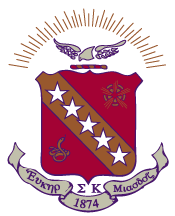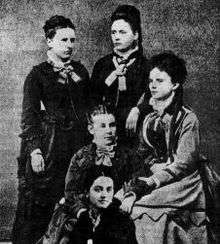Sigma Kappa
Sigma Kappa (ΣΚ, also known as SK or Sig Kap) is a sorority founded in 1874 at Colby College in Waterville, Maine.
| Sigma Kappa | |
|---|---|
| ΣΚ | |
 | |
| Founded | November 9, 1874 Colby College, (Waterville, Maine) |
| Type | Social |
| Scope | National |
| Motto | One Heart, One Way |
| Colors | Maroon Lavender |
| Symbol | Dove, Heart |
| Flower | Wild Purple Violet |
| Jewel | Pearl |
| Publication | Sigma Kappa Triangle |
| Philanthropy | Sigma Kappa Foundation, Inherit the Earth, Gerontology research, Maine Sea Coast Mission Alzheimer's disease research |
| Chapters | 122 collegiate, 110 alumnae |
| Members | 172,000 lifetime |
| Headquarters | 695 Pro Med Lane, Suite 300 Indianapolis, Indiana USA |
| Website | www |
In 1874, Sigma Kappa was founded by five women: Mary Caffrey Low Carver, Elizabeth Gorham Hoag, Ida Mabel Fuller Pierce, Frances Elliott Mann Hall and Louise Helen Coburn. The sorority has initiated 172,000 members, has 122 collegiate chapters, and has over 110 alumnae chapters. It is officially partnered with the Maine Sea Coast Mission to raise money for the Mission's programs, and it also includes gerontology with an emphasis on Alzheimer's disease and research its other initiatives.
The sorority is one of 26 members of the National Panhellenic Conference (NPC) of national women's fraternities, joining the conference in 1904.
History

In 1871, Mary Caffrey Low Carver became the first and only female student at Colby College in Maine until Elizabeth Gorham Hoag, Ida Mabel Fuller Pierce, Frances Elliott Mann Hall and Louise Helen Coburn were admitted and enrolled in 1873.[1] As the only women, they associated frequently and decided to form a society. They were instructed by the college administration that they would need to present a constitution and bylaws with a petition requesting permission to form Sigma Kappa. On November 9, 1874, the faculty approved their petition. Sigma Kappa annually celebrates November 9 as its Founders' Day.[1]
Low was the first woman to appear on the sorority's rolls and the first to preside over an initiation, of which Coburn wrote a large portion. The first Sigma Kappa emblem was designed by Hoag, who died shortly thereafter of tuberculosis. Much of the original initiation music was written by Hoag's cousin, Emily Peace Meader, who was inducted shortly before Hoag's death in 1875. Mann Hall was the first to marry (a fellow Colby student).
In the first constitution, chapters were limited to 25 members, and so Beta chapter and Gamma chapter were also established at Colby College as more joined. Early records indicate that the groups met together, but in 1893, the members voted to stop expanding inside the college, meaning that the Alpha chapter could initiate to the limit of 25, but Beta and Gamma chapters could initiate no more and would eventually disappear. The vote also meant that the members began expansion outside of Colby College.[1]
Expansion began in 1904 at Boston University,[1] and in 1905, Sigma Kappa joined the National Panhellenic Conference.[2] The sorority published first published its magazine, the Sigma Kappa Triangle, in 1907. In 1918, the sorority adopted a philanthropic partner, the Maine Sea Coast Mission, and in 1924, it established its first national headquarters in Reading, Massachusetts, which would move to Indianapolis, Indiana, in 1936. In 1937, it began sending out field consultants for collegiate chapters.[1]
In 1954, Sigma Kappa adopted gerontology as its third philanthropy.[1][2] In 1959, it absorbed another social sorority, Pi Kappa Sigma.[3] In 1962, it established a separate branch, the Sigma Kappa Foundation, to manage its philanthropy funds, and added Alzheimer's disease as a focus for its gerontology philanthropy in 1984. In 1992, it began another program as part of its gerontology initiatives, "Inherit the Earth". In 1993, it established a housing corporation.[1]
Symbols
Sigma Kappa's colors are lavender and maroon, chosen in 1891. In June 1892, the violet was adopted as the official flower and specified in 2008 as the Wild Purple Violet to distinguish it from other varieties of violets.[4] The pearl is the official jewel and was adopted in 1915, the year the official banner was also adopted.[1] The dove was accepted as an official symbol at the 1984 convention, and the heart was adopted at the 1988 convention.[4]
The Sigma Kappa coat-of-arms includes the symbols of the sorority: the dove, violet, Greek letters, and colors.[4] Adopted in 1911,[1] the coat-of-arms consists of a maroon shield with a diagonal gold bar on which are five lavender stars. The lower half has a coiled serpent, and the upper has a maroon and gold wreath. A silver dove is above the shield, with an arch of gold rays above the dove. Below is a silver scroll, bearing the open motto in black text and the date 1874.
Badges
The current membership badge is a one-inch jeweled triangle with Greek letters Σ and Κ.[2] The triangle badge was chosen in 1894,[1] and later, jeweled badges were approved at the 1915 convention when the pearl was adopted as the national jewel. Unjeweled badges have a scroll edge. Badges are either made of silver, white gold or yellow gold.
The new members pin is only worn during the new member period, and it is shaped as gold Greek "K" for Kappa with a serpent lacing through it to form a Greek "Σ" for Sigma.[2] This design was adopted as the new member pin in 1920.[1]
There are also alumni pins, 25-year pins, and 50-year pins, and the "Pearl Court Pin" which is given to recipients of the Ernestine Duncan Collins Pearl Court Award, which is a national award given by the organization.
Philanthropies
In 1962, Sigma Kappa established a separate branch, the Sigma Kappa Foundation, and in 1989, it was incorporated as a 501(c)(3) nonprofit organization. Chapters raise funds for the Foundation, which then grants the funds towards: scholarships for leadership and tuition for its collegiate members,[5] alumnae chapter funds,[6] alumnae and collegiate crisis relief,[5] and collegiate project grants,[5] while donations made with specific restrictions may be given to specific scholarships or causes such as Alzheimer's research.[5]
At a 1918 convention, the sorority voted to partner with the Maine Sea Coast Mission to aid communities and ecologies of coastal Maine. In 1954, gerontology was adopted as another main philanthropy of Sigma Kappa, with members encouraged to volunteer with the elderly. Beginning in 1984, the sorority added an emphasis on Alzheimer's disease research. The sorority also has an "Inherit the Earth" project that has goals of improving local environments.[7]
Many collegiate chapters of Sigma Kappa participate in The Walk to End Alzheimer's to raise money for the Alzheimer's Association. This money does not go through the Sigma Kappa Foundation but directly to the Alzheimer's Association. According to the Foundation's website: "Since becoming a Platinum National Walk team in 2016, Sigma Kappa has consistently raised more than $1,000,000 annually. In 2019, Sigma Kappa will become a Diamond Level National Walk Team, the highest level for a national team for the Alzheimer's Association."[8] Some chapters may also participate host a variety of fundraising events called "Ultra Violet", a concept introduced in 2008,[1] where all funds raised go to the Foundation's PULSE fund.[8]
Membership
As with all National Panhellenic Conference (NPC) sororities, women may join Sigma Kappa if they attend as an undergraduate a university with an active chapter from which they receive a membership offer.[9] Prospective members must meet the fraternity's national minimum GPA requirement (2.5/4.0) as well as the chapter's requirement. Alternatively, women past college-age may be invited or may apply to join via alumnae initiation if they are not already a member of another NPC sorority,[10] a process which 20 of the 26 NPC members also participate in.[11] Due to NPC agreements, no woman who has been initiated into another NPC sorority may join another one, although no NPC member is restricted from joining a professional or service Greek letter organization.
Notable Sigma Kappas
According to the sorority, it has initiated more than 172,000 women.[12]
Chapters
Sigma Kappa has 122 collegiate chapters and 110 alumnae chapters.[12]
The Delta chapter of Boston University is now the oldest existing chapter. The Eta Chapter of Illinois Wesleyan University is the longest continuously running chapter. In 1984, Colby College banned fraternities and sororities,[13] ensuring that the Alpha chapter will probably never be resurrected.
In 2005, Sigma Kappa's Mu Chapter House at the University of Washington obtained City of Seattle Landmark status, becoming the only sorority or fraternity in Seattle to achieve Historic Landmark status both at the City of Seattle and on the National Historic Register.[14]
Controversies
In 2014, the University of North Carolina at Charlotte chapter performed a Pocahontas-themed skit that involved dressing up in redface.[15]
See also
- Sigma Delta, former chapter at Dartmouth College.
References
- "History | Sigma Kappa". sigmakappa.org. Retrieved 2019-09-03.
- "Manual of Information" (PDF). National Panhellenic Conference. Jan 2018. Retrieved 2018-06-17.
- Baird's Manual of American College Fraternities. 1991.
- "About Us". Sigma Kappa. Retrieved 2019-09-03.
- "Scholarships & Grants". Sigma Kappa. Retrieved 2019-09-03.
- "Alumnae PULSE Award". Sigma Kappa. Retrieved 2019-09-03.
- "Philanthropy". Sigma Kappa. Retrieved 2019-09-03.
- "Fundraising". Sigma Kappa Foundation. Retrieved 2019-09-03.
- "How Sororities Work". HowStuffWorks. 2007-08-06. Retrieved 2018-06-27.
- "Alumnae Initiate Program". Sigma Kappa. Retrieved 2019-09-03.
- "sorority Q&A: thinking about alum initiation…". Retrieved 2018-05-10.
- "Why Sigma Kappa". Sigma Kappa. Retrieved 2019-09-03.
- "Fraternities banned at Colby -- members 'disappointed'". United Press International. 16 January 1984. Retrieved 2 June 2020.
- "National Register of Historic Places Registration Form". NPGallery. 12 April 2007. Retrieved 4 May 2020.
- Schilling, Vincent (2014-04-25). "UNCC Apologizes for Sigma Kappa Redface Act, but Sorority Remains Mum". Indian Country Today. Retrieved 2019-09-03.